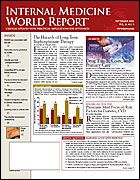Publication
Article
Internal Medicine World Report
Controlling Intragastric Acid Can Heal Erosive Esophagitis
Author(s):
From Digestive Disease Week
LOS ANGELES?Controlling intragastric acid does appear to improve the healing of erosive esophagitis and lessen the symptoms of gastroesophageal reflux disease (GERD), based on new data reported at Digestive Disease Week.
Erosive esophagitis occurs when the lining of the esophagus is damaged from reflux (into the esophagus) of gastric acid with a pH level <4.0, said investigator Philip Katz, MD, of the Albert Einstein Medical Center, Philadelphia. And although it seems that controlling reflux should help heal erosive esophagitis, this has never been proven in a prospective trial.
Helicobacter pylori
Included in the study were 169 patients with moderate-to-severe erosive esophagitis, defined as Los Angeles (LA) grade C or D. Of the 103 evaluable patients (mean age, 48.7 years; 67% men), 92% had LA grade C erosive esophagitis, and most (92%) were ?negative.
The patients were randomized to 1 of 2 doses of esomeprazole (Nexium)? 10 or 40 mg/day?but the aim of the study was to examine the role of acid control in healing esophagitis rather than the effects of the 2 different doses.
Esophagogastroduodenoscopy was performed at baseline and at the end of the study. Dual-channel intragastric/intraesophageal pH monitoring was performed on day 5 using a pH probe placed at the lower esophageal sphincter.
Primary end points were the percentage of time patients had a pH >4.0 after 5 days of treatment with esomeprazole ?and degree of healing after 4 weeks of treatment.
Secondary end points were the relationship between acid control and the resolution of heartburn, general symptoms of heartburn, acid regurgitation, epigastric pain, and dysphagia; erosive esophagitis healing and the use of rescue medication; and the control of intraesophageal pH, along with erosive esophagitis healing.
At the end of 4-week treatment with acid control, analysis confirmed a significant relationship between patients' percentage of time with acid control (ie, time with intragastric pH >4.0) and the degree of healing of erosive esophagitis.
The mean percentage of time with acid control was 61.3% in patients with healed erosive esophagitis compared with 42.2% in those whose esophagitis had not healed (P?= .002).
P
Acid control also correlated significantly with daytime heartburn, nighttime heartburn, and acid regurgitation. Healed patients used fewer rescue medications than those who had not healed (0.45/d vs 0.91/d; ?= .098).
Some secondary measures, including dysphagia and epigastric pain, did not correlate with acid control. But a post hoc analysis revealed a positive correlation between esophageal acid control and healing status (healed status correlated 95.2% of the time with pH >4.0 compared with 88.9% of the time in nonhealed status).
Dr Katz concluded, "Longer duration of intragastric control on day 5 is associated with an increased likelihood of erosive esophagitis healing at 4 weeks."
That same acid control, he continued, correlates with less severe GERD symptom scores at week 4 for daytime and nighttime heartburn, and acid regurgitation. Thus, "intragastric acid control is a clinically relevant measure of drug efficacy in the treatment of patients with moderate-to-severe erosive esophagitis," he noted.





